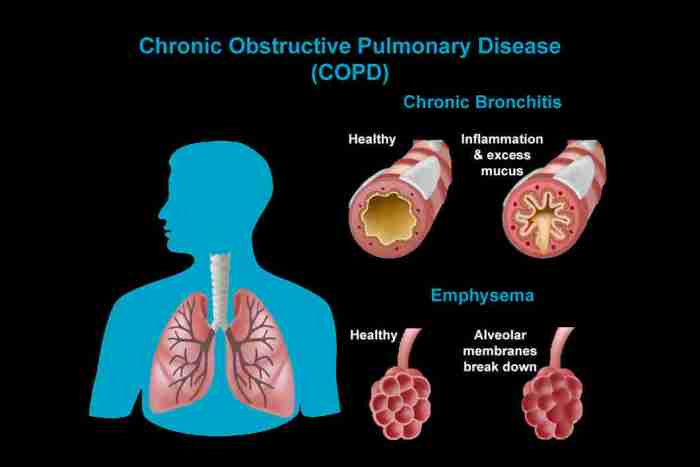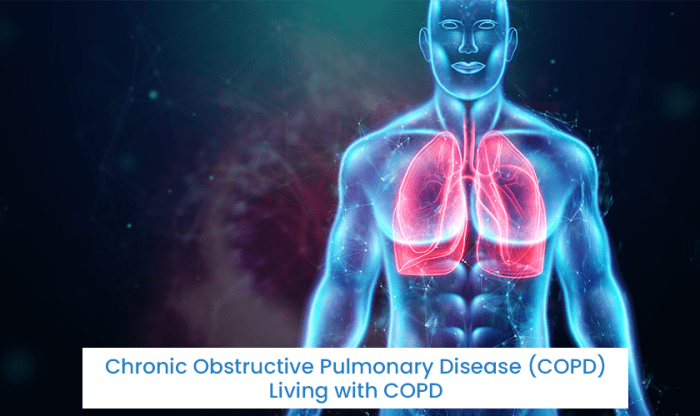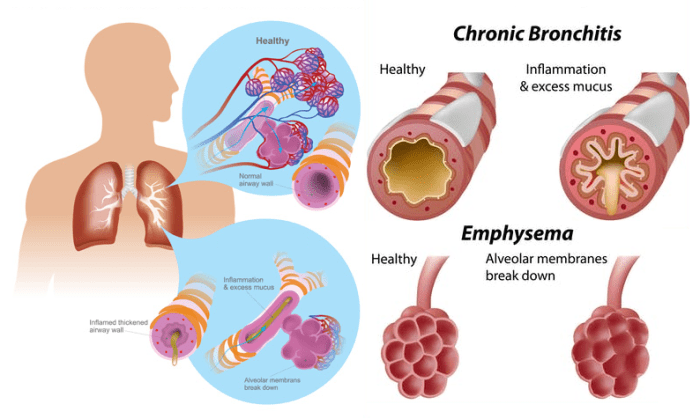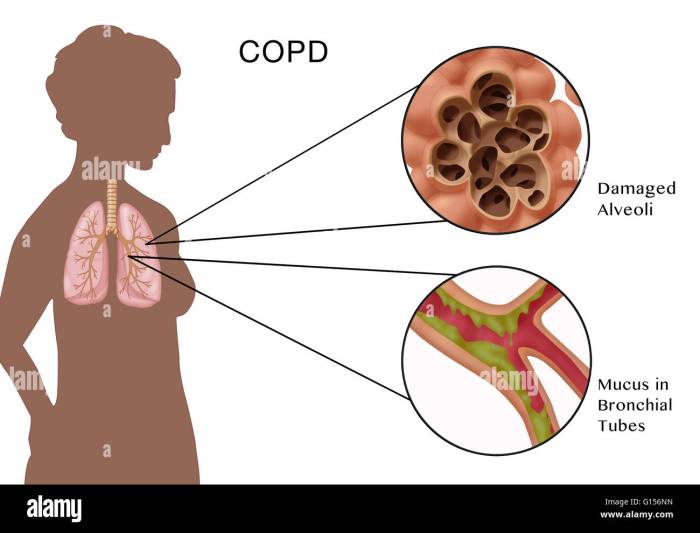Why does COPD cause increased mucus production? This question delves into the complex interplay of inflammation, structural changes, genetics, and environmental factors that lead to this hallmark symptom of Chronic Obstructive Pulmonary Disease. We’ll explore the underlying mechanisms, from the inflammatory processes in COPD airways to the impact of chronic bronchitis and smoking on mucus production. We’ll also examine the structural changes in COPD airways, the role of genetic predisposition and environmental exposures, and the distinct characteristics of COPD mucus itself.
Understanding these factors is crucial for developing effective therapeutic strategies, including mucolytic therapies and pulmonary rehabilitation, to help manage this often debilitating aspect of COPD.
Underlying Mechanisms of COPD

Chronic Obstructive Pulmonary Disease (COPD) is a progressive lung disease characterized by persistent airflow limitation. A key feature of COPD is the chronic inflammation and damage to the airways, which ultimately leads to increased mucus production. Understanding the underlying mechanisms driving this mucus hypersecretion is crucial for developing effective treatments.The inflammatory processes within the COPD airways are complex and multifaceted, contributing significantly to the characteristic mucus overproduction.
These inflammatory responses involve a cascade of events, from the initial triggering stimuli to the ultimate effect on the mucus-producing cells. Oxidative stress, a byproduct of inflammation, plays a critical role in exacerbating this process, further damaging the airways and promoting mucus hypersecretion.
Inflammatory Processes in COPD
Chronic inflammation is a hallmark of COPD, characterized by the infiltration of various immune cells into the airways. This inflammation triggers a cascade of events that lead to mucus hypersecretion. The recruitment and activation of these inflammatory cells release a plethora of inflammatory mediators, which further exacerbate the inflammatory response and contribute to the damage of the airways.
This, in turn, leads to an overproduction of mucus.
Role of Oxidative Stress
Oxidative stress, a condition resulting from an imbalance between reactive oxygen species (ROS) and antioxidant defenses, is a significant contributor to COPD pathogenesis. Elevated ROS levels damage airway epithelial cells, triggering inflammatory responses, and stimulating the mucus glands to produce excessive mucus. This oxidative stress-induced damage compromises the normal function of the airways, leading to the characteristic symptoms of COPD.
Comparison of Mucus Production
Healthy airways exhibit a tightly regulated mucus production system. The production and clearance of mucus are carefully orchestrated to maintain a healthy airway environment. In contrast, COPD airways display a dysregulated mucus production process. This dysregulation leads to excessive mucus accumulation, which obstructs airflow and impairs gas exchange.
Impact of Chronic Bronchitis on Goblet Cell Hyperplasia
Chronic bronchitis, a key component of COPD, is characterized by chronic inflammation and mucus hypersecretion. This persistent inflammation stimulates goblet cell hyperplasia, which is the excessive growth of mucus-producing goblet cells in the airway epithelium. The increased number of goblet cells directly contributes to the increased mucus production observed in COPD patients.
Inflammatory Mediators in COPD-Related Mucus Hypersecretion
Several inflammatory mediators are implicated in the mucus hypersecretion associated with COPD. These mediators include cytokines like interleukin-8 (IL-8), tumor necrosis factor-alpha (TNF-α), and transforming growth factor-beta (TGF-β). These cytokines play a crucial role in the recruitment and activation of inflammatory cells, which ultimately contributes to the overproduction of mucus.
Interaction Between Immune Cells and Mucus Glands
Immune cells, such as neutrophils, macrophages, and lymphocytes, play a crucial role in the interaction with mucus glands in COPD airways. The activation and infiltration of these immune cells into the airways release inflammatory mediators that stimulate mucus glands to produce excessive mucus. This interaction creates a vicious cycle, further exacerbating the inflammatory response and contributing to the progression of COPD.
COPD, or chronic obstructive pulmonary disease, often leads to increased mucus production due to inflammation in the airways. This inflammation triggers the body’s natural defense mechanisms, which unfortunately sometimes result in excessive mucus. Interestingly, understanding the intricate workings of the human digestive system, particularly the colon, can offer some insight into this response. For example, similar inflammatory responses in the colon can lead to problems like diarrhea and constipation.
Learning more about these fascinating details about your colon can help us better understand the body’s complex reactions. facts about your colon This increased mucus in COPD patients is a critical factor in their respiratory symptoms and the need for effective treatments.
Inflammatory Cells in COPD Airways
| Cell Type | Potential Role in Mucus Production | Specific Actions | Evidence/Examples |
|---|---|---|---|
| Neutrophils | Prominent contributors to mucus production. | Release proteases and inflammatory mediators. | Increased neutrophil infiltration correlates with mucus hypersecretion. |
| Macrophages | Modulate mucus production through cytokine release. | Secrete cytokines like TNF-α and IL-1β. | Macrophage-derived cytokines stimulate goblet cell hyperplasia. |
| Lymphocytes | Contribute to the chronic inflammatory response. | Release cytokines and chemokines. | Th2 lymphocytes are implicated in mucus production. |
Pathways and Signaling Molecules in Mucus Production
| Pathway | Signaling Molecule | Role in COPD | Evidence/Examples |
|---|---|---|---|
| TGF-β signaling | TGF-β | Stimulates goblet cell hyperplasia. | TGF-β expression is elevated in COPD airways. |
| NF-κB signaling | NF-κB | Regulates mucus gene expression. | NF-κB activation promotes mucus production. |
| IL-8 signaling | IL-8 | Recruitment and activation of inflammatory cells. | IL-8 levels are elevated in COPD exacerbations. |
Structural Changes in COPD Airways
Chronic Obstructive Pulmonary Disease (COPD) isn’t just about impaired lung function; it fundamentally alters the structure of the airways. These structural changes significantly impact mucus production, clearance, and ultimately, the disease’s progression. Understanding these changes is crucial for developing effective therapeutic strategies.The structural remodeling in COPD airways leads to a vicious cycle. The initial inflammatory response, driven by various factors, triggers a cascade of events that reshape the airway architecture.
This, in turn, affects mucus production and clearance, contributing to the characteristic symptoms and complications of the disease.
Airway Wall Thickening and Destruction
Airway wall thickening is a hallmark of COPD. Inflammation, oxidative stress, and protease-antiprotease imbalance lead to the accumulation of inflammatory cells and extracellular matrix components within the airway walls. This thickening impedes airflow and hinders the movement of mucus, leading to its accumulation. Additionally, the destruction of alveolar walls in emphysema, a key component of COPD, further exacerbates mucus issues.
The loss of alveolar support leads to reduced airway surface area, contributing to mucus retention.
Reduced Cilia Function
Cilia, tiny hair-like structures lining the airways, play a critical role in mucus clearance. In COPD, the function of these cilia is impaired due to the inflammatory environment and oxidative stress. This dysfunction compromises the efficient removal of mucus, resulting in its accumulation and increased susceptibility to infection. In severe cases, cilia may be completely absent, leading to a complete blockage of the mucus clearance mechanism.
Emphysema and Mucus Production
Emphysema, characterized by the destruction of alveolar walls, significantly impacts mucus production. The loss of alveolar support reduces the overall surface area for mucus to be removed. This, combined with impaired cilia function, leads to a significant accumulation of mucus in the airways, contributing to airway obstruction and the difficulty in breathing associated with COPD.
COPD Subtypes and Mucus Production
Different COPD subtypes, while sharing the underlying structural changes, may exhibit varying degrees of mucus production and airway inflammation. For example, patients with a predominant chronic bronchitis phenotype might have more pronounced mucus hypersecretion compared to those with a predominantly emphysematous phenotype. The specific inflammatory mediators and the degree of airway wall remodeling vary, influencing the level of mucus production.
Summary Table: Structural Changes in COPD Airways
| Structural Change | Correlation with Mucus Production | Potential Mechanisms | Examples |
|---|---|---|---|
| Airway wall thickening | Increased mucus production and accumulation | Inflammation, extracellular matrix deposition, reduced airflow | Increased goblet cell metaplasia, subepithelial fibrosis |
| Alveolar wall destruction (Emphysema) | Reduced mucus clearance, increased mucus accumulation | Loss of alveolar support, reduced surface area for mucus removal | Loss of lung elasticity, reduced expiratory flow |
| Reduced cilia function | Increased mucus accumulation, impaired clearance | Inflammation, oxidative stress, impaired ciliary motility | Reduced ciliary beat frequency, ciliary damage |
Impact of Airway Remodeling on Mucus Transport, Clearance, and Accumulation
| Airway Remodeling Feature | Impact on Mucus Transport | Impact on Mucus Clearance | Impact on Mucus Accumulation |
|---|---|---|---|
| Airway wall thickening | Impeded mucus transport | Reduced mucus clearance efficiency | Increased mucus accumulation |
| Emphysema | Reduced mucus transport due to altered surface area | Impaired mucus clearance due to loss of alveolar support | Increased mucus accumulation in the remaining airways |
| Reduced cilia function | Decreased mucus transport speed | Ineffective mucus clearance | Significant mucus accumulation, leading to airway obstruction |
Genetic and Environmental Factors

The development of Chronic Obstructive Pulmonary Disease (COPD) is a complex interplay of genetic predisposition and environmental triggers. While smoking is a major environmental risk factor, other exposures and individual genetic variations play significant roles in the disease’s progression and the associated mucus hypersecretion. Understanding these factors is crucial for developing targeted prevention and treatment strategies.Genetic predisposition can influence a person’s susceptibility to COPD and the severity of the disease, including mucus hypersecretion.
Environmental exposures, such as air pollution and occupational hazards, can exacerbate the condition and contribute to increased mucus production. The interplay between these factors is intricate, and further research is needed to fully elucidate these complex relationships.
COPD, or chronic obstructive pulmonary disease, often leads to increased mucus production due to the inflammation and damage to the airways. This constant irritation triggers the body’s defense mechanisms, resulting in a heightened production of mucus to try and clear the airways. Interestingly, similar inflammation responses can be seen in allergic reactions, and it’s worth exploring if these responses overlap; for example, can allergies cause body aches?
can allergies cause body aches This increased mucus production in COPD, however, is usually a more persistent and chronic problem, unlike the temporary discomfort that might arise from an allergy.
Genetic Predisposition in COPD-Related Mucus Hypersecretion
Genetic variations can affect the regulation of genes involved in mucus production, inflammation, and the immune response, increasing susceptibility to COPD. Individuals with certain genetic profiles may be more prone to mucus hypersecretion, leading to airway obstruction and exacerbations.
Impact of Environmental Exposures on Mucus Production
Environmental exposures, particularly smoking, have a profound impact on mucus production in COPD. Cigarette smoke directly irritates the airways, triggering inflammation and stimulating mucus-producing cells. This sustained inflammation leads to increased mucus production and a thickened mucus layer, further hindering airflow.
Interactions Between Genetic Factors and Environmental Triggers
Genetic predisposition and environmental triggers interact in complex ways to determine the development and severity of COPD. Individuals with a genetic susceptibility to COPD may be more vulnerable to the detrimental effects of environmental exposures like smoking, leading to a more pronounced response in mucus hypersecretion. For example, a person with a genetic variation predisposing them to inflammation might experience a more severe exacerbation after exposure to air pollution.
Examples of Genetic Variations Associated with Increased Mucus Production
Several genes have been linked to increased mucus production in COPD. These genes often regulate the immune response, inflammatory processes, and the function of mucus-producing cells. While the specific genetic variations are still being investigated, research has highlighted some candidate genes that are worth further study. Further research will identify more specific genetic variations.
Potential Environmental Factors Besides Smoking
Besides smoking, other environmental exposures can contribute to mucus hypersecretion in COPD. Air pollution, particularly particulate matter and ozone, can induce inflammation and increase mucus production. Occupational exposures to dust, fumes, and other irritants can also contribute to the disease process. Even exposure to certain viral infections may increase mucus production and airway inflammation.
Mucus Production Patterns in COPD Patients with Different Smoking Histories
COPD patients with different smoking histories may exhibit different mucus production patterns. Heavy smokers often show a more pronounced and consistent increase in mucus production compared to those with a lower smoking history or never smokers. However, factors beyond smoking history, such as the duration of exposure, the intensity of exposure, and co-morbidities, influence the individual response to environmental triggers.
Influence of Air Pollution on COPD
Air pollution can significantly influence the inflammatory response and mucus production in COPD. Pollutants like particulate matter and ozone irritate the airways, triggering an inflammatory cascade that increases mucus production and exacerbates existing COPD symptoms. This effect is especially concerning in urban areas with high levels of air pollution. The severity of the response varies among individuals, highlighting the complex interplay between genetics and environment.
Genetic Variations Linked to COPD and Mucus Production
| Genetic Variation | Gene | Potential Impact on Mucus Production | Further Research Needed |
|---|---|---|---|
| Example Variation 1 | Example Gene 1 | Increased mucus production and airway inflammation | Yes |
| Example Variation 2 | Example Gene 2 | Altered immune response, potentially leading to increased mucus production | Yes |
| Example Variation 3 | Example Gene 3 | Impaired mucociliary clearance, leading to mucus accumulation | Yes |
Note: This table provides examples and is not an exhaustive list. The specific genetic variations and their impact on mucus production in COPD are still under investigation.
Mucus Characteristics in COPD
COPD, characterized by persistent airflow limitation, significantly alters the properties of mucus within the airways. This change in mucus, often referred to as mucus hypersecretion, plays a critical role in the progression and severity of the disease. Understanding the altered composition and characteristics of this mucus is vital for developing effective treatments and management strategies.The composition and physical properties of mucus, such as viscosity and elasticity, are profoundly affected in COPD.
These changes contribute to airway obstruction and impair lung function, leading to the characteristic symptoms of the disease. This section will explore the specific modifications to mucus in COPD, examining its components, their alterations, and the consequences for lung health.
Changes in Mucus Composition
COPD-related mucus abnormalities extend beyond simply increased production. The composition of the mucus itself undergoes substantial modifications, impacting its overall properties. The altered balance of components leads to a thicker, stickier, and more difficult-to-clear mucus, compounding the problem of airway obstruction.
Components of Mucus and Their Alterations
Mucus is a complex mixture of water, proteins, and glycoproteins. In healthy individuals, these components are carefully balanced, allowing for effective airway clearance. In COPD, this balance is disrupted. Increased production of mucins, a key class of glycoproteins, is observed, leading to a higher overall concentration of these substances in the mucus. Furthermore, changes in the type and quantity of other proteins and inflammatory mediators are also noted, contributing to the altered characteristics of COPD mucus.
Impact of Viscosity and Elasticity
The viscosity (thickness) and elasticity (ability to stretch and recoil) of mucus are significantly affected in COPD. Increased viscosity makes the mucus more resistant to flow, hindering its movement through the airways. Decreased elasticity, conversely, results in a less easily cleared mucus, increasing the risk of airway obstruction and exacerbations. This increased viscosity and decreased elasticity lead to a “sticky” and less flexible mucus, contributing to the difficulty in clearing mucus from the airways.
Examples of Distinguishing Characteristics
COPD mucus often displays characteristics that differentiate it from healthy mucus. For example, it may appear more opaque or viscous, exhibiting a stickier consistency. The mucus may also be more difficult to clear, contributing to a buildup in the airways.
Mucus Characteristics Across COPD Stages
The characteristics of mucus can vary across the different stages of COPD. In early stages, the changes might be subtle, with only a slight increase in mucus production and viscosity. As the disease progresses, the mucus becomes thicker, more difficult to clear, and more consistently present in the airways, causing more severe airway obstruction.
COPD often leads to increased mucus production because the airways become inflamed and irritated. This inflammation triggers the body’s immune response, leading to an overproduction of mucus as a defense mechanism. Interestingly, similar inflammatory responses can impact other areas of health. For example, wondering if losing weight could help lower your heart disease risk? Check out this expert advice: ask an expert will losing weight lower my heart disease risk.
Ultimately, understanding the inflammatory processes behind COPD is key to managing its symptoms, like that excess mucus.
Mechanisms Behind Mucus Hypersecretion
Mucus hypersecretion in COPD is a complex process involving a combination of factors. Chronic inflammation, a hallmark of COPD, plays a significant role. Inflammatory mediators trigger increased mucus production by goblet cells and submucosal glands, which results in a larger volume of mucus in the airways. Furthermore, the chronic infection commonly associated with COPD can contribute to this hypersecretion.
Impact on Lung Function
The impact of mucus hypersecretion on lung function is substantial. The increased mucus volume and altered viscosity create a physical barrier to airflow. This barrier leads to a reduction in lung capacity and diminished gas exchange efficiency. This compromised function is a key contributor to the dyspnea (shortness of breath) and other respiratory symptoms characteristic of COPD.
Comparison of Healthy and COPD Mucus
| Component | Healthy Mucus | COPD Mucus | Key Differences |
|---|---|---|---|
| Water | High proportion | Lower proportion | Reduced hydration, increased viscosity |
| Mucins | Balanced proportion | Increased proportion | Increased viscosity, reduced elasticity |
| Proteins | Balanced proportion | Potentially altered proportion | May include inflammatory mediators |
| Electrolytes | Balanced | Potentially altered | May affect hydration and viscosity |
Mucus Contribution to Airway Obstruction
The thickened, sticky mucus in COPD airways significantly impedes airflow. The increased viscosity of the mucus creates a substantial resistance to airflow, particularly during exhalation. This increased resistance leads to a narrowing of the airways, impeding the efficient movement of air in and out of the lungs. The reduced elasticity of the mucus further contributes to this obstruction, hindering the ability of the airways to return to their normal shape after each breath.
This combination of factors results in the characteristic airflow limitation seen in COPD patients.
Therapeutic Strategies: Why Does Copd Cause Increased Mucus Production
Managing COPD often involves a multi-faceted approach, including lifestyle modifications, medication, and pulmonary rehabilitation. A crucial aspect of this management is addressing mucus hypersecretion, a key symptom contributing to exacerbations and reduced lung function. Mucolytic therapies play a vital role in this process.Effective COPD management necessitates a comprehensive understanding of mucolytic therapies, their mechanisms, and limitations. This section delves into the role of mucolytics, highlighting different types, their efficacy, potential side effects, and the importance of pulmonary rehabilitation.
Mucolytic Therapies in COPD
Mucolytics are medications designed to thin and loosen the thick, tenacious mucus that accumulates in the airways of COPD patients. This facilitates easier clearance of mucus, reducing the frequency and severity of exacerbations and improving overall lung function. Various mucolytic agents target different aspects of mucus viscosity and hydration, leading to differing effectiveness and potential side effects.
Rationale Behind Different Mucolytic Therapies
The rationale behind various mucolytic therapies for COPD stems from their diverse mechanisms of action. Some agents, like N-acetylcysteine (NAC), work by reducing disulfide bonds in mucus glycoproteins, thereby decreasing viscosity. Others, such as erdosteine, focus on improving the hydration of mucus, making it less viscous. The choice of mucolytic agent often depends on individual patient factors, including the severity of mucus hypersecretion, the presence of comorbidities, and the patient’s overall health status.
Limitations and Potential Side Effects of Mucolytic Treatments
While mucolytics can be beneficial, they are not without limitations and potential side effects. Some patients may experience gastrointestinal upset, including nausea, vomiting, or diarrhea. Allergic reactions, although less common, can occur. Furthermore, the effectiveness of mucolytics can vary significantly between individuals, and some may not experience substantial improvements in mucus clearance. Close monitoring of patients undergoing mucolytic therapy is crucial to identify and manage any adverse effects promptly.
Examples of Successful Mucolytic Interventions in COPD, Why does copd cause increased mucus production
Numerous case studies and clinical trials have demonstrated the potential benefits of mucolytic therapies in COPD management. For instance, a study published in the European Respiratory Journal showed that patients treated with NAC experienced a significant reduction in exacerbations and an improvement in lung function compared to a control group. These successes underscore the importance of mucolytic interventions in alleviating COPD symptoms.
Comparison of Mucolytic Agents in COPD
Comparing the effectiveness of different mucolytic agents is complex. Factors such as the specific mechanism of action, dosage, and patient characteristics influence the outcome. While NAC remains a widely used and studied mucolytic, other agents like erdosteine offer potential advantages in specific situations. Further research is needed to establish definitive comparisons across various agents.
Innovative Therapeutic Approaches for Managing Mucus Hypersecretion
Innovative approaches to managing mucus hypersecretion in COPD are constantly evolving. Research into novel mucolytic agents, as well as combination therapies with other medications, are ongoing. Strategies aimed at improving airway hydration and reducing inflammation are also promising avenues of investigation. These advances may lead to more effective and targeted treatments for COPD patients in the future.
Pulmonary Rehabilitation and Mucus Clearance
Pulmonary rehabilitation programs are crucial in improving mucus clearance in COPD patients. These programs often include techniques like breathing exercises, postural drainage, and airway clearance therapies. These techniques aid in improving lung function, reducing mucus accumulation, and ultimately improving the overall quality of life for COPD patients. The combined approach of mucolytics and pulmonary rehabilitation can lead to significant improvements in symptom management.
Summary Table of Mucolytic Agents
| Mucolytic Agent | Mechanism of Action | Effectiveness in COPD | Potential Side Effects |
|---|---|---|---|
| N-acetylcysteine (NAC) | Reduces disulfide bonds in mucus glycoproteins | Generally effective in reducing exacerbations and improving lung function | Gastrointestinal upset, allergic reactions |
| Erdosteine | Improves mucus hydration | Potentially effective in certain cases | Gastrointestinal upset, skin reactions |
| Other agents | Vary based on mechanism | Effectiveness varies based on individual responses and specific agent | Individual agent specific |
Last Point
In summary, COPD’s increased mucus production stems from a multifaceted cascade of events. Inflammation, structural changes, genetic predisposition, and environmental factors all contribute to the overproduction of mucus, which significantly impacts lung function. Understanding the intricacies of these mechanisms is essential for developing targeted therapies and improving the lives of those affected by COPD. The complex relationship between COPD and mucus underscores the need for further research into innovative treatment approaches.










